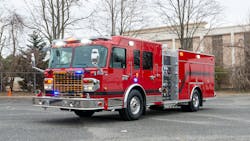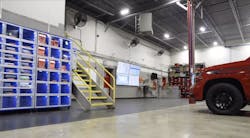Fire engine dealer fights tech shortage with clean, lean strategy
Hendrickson Fire Rescue Equipment, a firetruck delaership based in Islandia, New York, knows what a truck needs to put out a fire. Aside from enough water in the tank and pressure to deliver the stream to extinguish the blaze, these trucks need preventive maintenance and repairs to ensure uptime and reliability enough. And that can only be delivered by enough able-bodied techs. In this respect, their service center can’t afford to be short-handed, or emergency response efforts could be impacted.
Luckily, the company’s focus on efficiency and fair pay keep the shop's bays full. One new issue though is that many of their older technicians, who’ve faithfully served for 30 to 40 years, are ready to retire.
“We were at a spot a number of years ago where we needed to replace them,” Hendrickson Fire President Craig Probst said. “How we've done it is [by creating] a business that is attractive.”
Developing a strategy to make your shop more attractive was the main subject at a recent Fullbay webinar held on Nov. 14. There, Probst and Hendrickson Chief Operating Officer Kevin Crump sat down with Fullbay CEO Patrick McKittrick and COO Chris O’Brien to examine how a shop can be more than just a good-looking place to work, but an operationally attractive one, too.
Read more: How mentorship increases retention
Shifting technician expectations
When it comes to attracting new talent, Probst and Crump know that their shop needs to reflect the life-saving work they do.
“The younger generation that's coming into this field might look into what used to be an old diesel repair shop and see something that looked a little bit like a dungeon: poorly lit, greasy, grimy, a mess,” Crump explained. And according to him, that’s not the kind of vision younger techs are looking for. “In their mind's eye, they see a cleaner, more elite type of work environment.”
So, that’s just what Hendrickson Fire Rescue Equipment strives to provide, especially because of how their technician recruitment is increasingly funneling from word-of-mouth networking instead of online services, like Indeed.
“Sometimes you'll have prospective technicians reach out to you, and they’ll have heard about us through word of mouth through channels you don't even expect,” Crump said.
That just emphasizes Hendrickson’s need to make a good first impression on whoever walks through their door, whether it’s a uniform vendor, a utility worker, or a prospective technician.
Clean and lean
One of the first steps to ensuring cleanliness is keeping the massive variety of tools found in any shop organized. Probst noted that his technicians wasted a lot of time searching for a tool they needed and who had it last. To solve the problem, Hendrickson partnered with Fastenal, a supply chain management solution provider. With Fastenal’s help, the shop began storing their hardware in a locker system. Now when a technician needs a certain item, they input their identification, the bin they want to access, and the repair order they’re working on, and then they’re able to access the diagnostic tool they need.
“If they don't return [the tool], you get an email so you know that that tech didn't check it back in,” Probst explained. “It's really allowed us to not lose a lot of this expensive equipment.”
The system works so well that they also began using it for their consumable products, which works something like a vending machine, the Hendrickson president explained.
Additionally, the company uses a more streamlined approach to general neatness, too, by employing a keystone of lean opeartions, the Five S system. The five ‘S’ categories include ‘Sort,’ which requires that nothing remains on the floor, ‘Set’ which calls for every item returning to a consistent place when not in use, ‘Shine’ to ensure all equipment is well-kept and the floors are clean, and then ‘Sustain’ and ‘Standardize’ for consistency. Hendrickson offers 10 to 15 minutes at the beginning of each day to allow their technicians to tidy and prepare everything they need. Then, to make sure that everyone is accountable to the Five S system, Hendrickson also started a text thread specifically for cleanliness.
“One of the big frustrations that you have when you try to achieve accountability with shop cleanliness is that techs are frustrated about the behavior of other techs,” Crump said. “But one of the things that came out of the texting capability is that any given tech, when they see an area that doesn't match the standard, such as an oil pan or dirty rags that were left out, they'll take a picture of it and post it on the Five S text thread. We all see it; all the techs see it, the leadership team sees it, but they have some fun with it, too.”
In this way, the social pressure from their peers helps keep the shop clean, as well as some assistance from hired utility works that take care of small jobs like moving trucks or setting up floor jacks.
Focusing on fires
To make sure their operations are as clean as their floors, Hendrickson Fire Rescue Equipment works to over-communicate with their techs and their customers. A core part of this strategy is four monitors Hendrickson groups in the bay area, each which displays a different work metric.
The first monitor handles job assignments, showing every job and their priority level so that each tech knows what their schedule looks like from the start. The bottom right monitor reports on every truck on the property and reflects their status via green, yellow, and red color coding, providing an ‘at-a-glance’ status report on each vehicle. The third monitor offers similar reporting on technician job statuses, so that anyone can evaluate a technician’s actual job hours versus their expected invoice hours, which helps to control both costs and shop efficiency. Finally, the last monitor tracks labor rates for work done on specific jobs, allowing for full transparency so that the customer can review any incoming costs and stay updated on the job.
But the prominently displayed shop monitors aren’t just there for easy status reports. They serve as a meeting point, too.
“We start every morning with a toolbox meeting, with all our techs around those boards,” Probst noted.
These ‘toolbox meetings’ include an overview of the day’s priorities, which trucks need to be on their way out, ensuring everyone’s schedule is coordinated, and double-checking for any scheduling gaps. Additionally, Probst will use these meetings to discuss any quality or safety issues from the day before.
“Then once a day, our management team, including the service director, parts director, service writers, myself, and Kevin will meet in front of those boards, and we'll go through our daily operations meeting,” Probst continued. “We try to let that go no longer than 30 minutes, and we go through every truck that's on property.”
This allows the shop to continuously refocus and collaborate on which items need the most attention.
(Not) Burning paper
This kind of flexibility applies not just to Hendrickson Fire Rescue Equipment’s management style, but their wages and rates. According to Probst, the shop evaluates their rates on a quarterly basis to ensure they’re keeping up with costs, inflation, and their actual effective rate versus their general rates.
“We have a door rate of $175 an hour,” the Hendrickson president said. “It'd be great if we could get that all the time, every time. But we have discounts that we apply to warranty work and in-house to our sales department, so our real effective rate’s closer to $160.”
Gauging just what that door rate should be means comparing their rates to their competitors, often through conversations with their customers.
“We don't want to be the highest-priced guy,” Crump explained. “But it's okay to knock on the ceiling of what the market will bear periodically, just to figure out where that ceiling’s at, and then back off to a level that leaves you competitive in the marketplace.”
In concert with monitoring their rates, Hendrickson also works to deliberately increase their wages to keep up with inflation.
The company’s wage for starting techs is “in the mid-20s, as a starting point,” Probst noted. “The mid-40s is where we're at on the higher end of it. But we're trying to come up with ways that we can incentivize even above that, not just on that rate, but with different bonus plans.”
Currently, the shop is experimenting with bonuses in four categories: quality-check, utilization, efficiency, and safety.
For technicians serving in quality-check/mentorship positions, they get to take a certain percentage of the billable hours on the job. Additionally, the utilization bonus offers an additional $1/hour on last week’s clocked hours, as long as a technician is 93% utilized. Why 93%?
“We do set time aside for toolbox meetings, and housekeeping and cleanup of the shop,” Hendrickson’s COO said. “It's not billable, so we don't pass that that part on to the customer.”
The organization determines who gets an efficiency bonus by looking at actual hours compared to the invoice hours for each action item per tech. Currently, the shop’s goal is to reach 110% shop efficiency, and for all of a tech’s hours that are above 110%, the shop gives back 5% on the monetized amount of hours. This encourages technicians to avoid banging their heads against a stubborn job while their hours rack up.
“At the earliest logical moment, we want a technician to be able to say, ‘You know what, I've gone as far as I should go on this, I'm gonna go get a second opinion, I'm gonna go get a service advisor’s input,’” Crump offered. “It's okay to do that. Not only is it okay, we'll reward you for doing that. It's monetarily worthwhile for you not to keep running up those hours, and ask for help early and often.”
Finally, the last bonus Hendrickson is testing is a safety bonus, which the lead tech monitors and addresses at each toolbox meeting.
“If we go for a month without any lost time incidents, no techs have to go home or go to the doctor, and can’t come to work because they get hurt, he gets a small safety bonus,” Probst said.
All of these tactics have helped keep Hendrickson Fire Rescue a clean, efficient place to work that not only better serves their customers but helps attract new technicians.
About the Author

Alex Keenan
Alex Keenan is an Associate Editor for Fleet Maintenance magazine. She has written on a variety of topics for the past several years and recently joined the transportation industry, reviewing content covering technician challenges and breaking industry news. She holds a bachelor's degree in English from Colorado State University in Fort Collins, Colorado.

